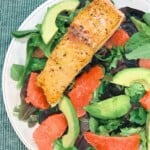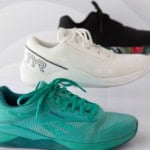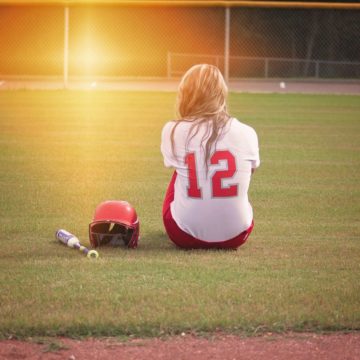
RED-S, Relative Energy Deficiency in Sport is a debilitating syndrome for teen athletes. It often includes disordered eating and keeps an athlete from thriving and competing. Here’s what you need to know about RED-S and disordered eating in teen athletes.
This article is written by Karli Himmelreic, and edited by Jenna Braddock.

My Story with Disordered Eating as a Teen Athlete
Sunny, 80 degrees, with a slight October breeze from the river near our middle-school fields. Sounds like the perfect Florida afternoon for a cross country practice, huh? Usually, but that day for me it meant another hour of pushing my body to its limits, which was feeling increasingly more difficult lately. It meant another hour of feeling lightheaded and ignoring my growling stomach while I pushed myself through another tempo run. The breeze hit my skin, and I shivered with goose bumps. I was always cold now, so I shook it off and went on the run. I fought to make sure my foot landed on the ground with each step so that I wouldn’t collapse from hunger. Shakily, I walked back to the track, stretched, and talked with my friends.
While navigating some stressful family dynamics at home, trying to be a good oldest child, and having a perfectionist-seeking attitude towards school work, I sought comfort in the one thing I felt that I could control in my busy and hectic life: that being control over how much, or rather, how little I ate. —
Effects On My Body
It did not take long for weight to shrink off of my already small frame. My skin turned yellowish, I developed a strange fuzz (called lanugo [6]) on my arms, my hair was falling out, my nails were flaking apart; all of my clothes were too big. I was so awfully fatigued, but I had trouble sleeping because I was so hungry. I was a straight-A student, but found it increasingly difficult to focus, particularly while fighting thoughts about the next meal I would allow myself, and how many calories it would be. In short, my body was shutting down, and I was miserable, despite the constant support and concern of my loved ones.
At the young age of eleven, I was diagnosed with an eating disorder called Anorexia Nervosa. This is a mental health disorder, characterized by weight loss and/or difficulty maintaining or refusal to maintain a healthy body weight, along with an intense fear of gaining weight, often accompanied by preoccupation with food and/or exercise and severe calorie restriction, among other symptoms [1]. In addition to this, my recreational activities as a runner and athlete also gave me another diagnosis, called “female athlete triad” [8].
I realize that this is a heavy history, but this is also a success story so stick with me. I share all of this to bring to light the fact that eating disorders can happen to anyone, at any age. It is my hope that through sharing my story, explaining these conditions, and providing some resources for parents and their children that together we can foster healthy minds and healthy bodies for our female athletes of all ages.
Female Athlete Triad now called Relative Energy Deficiency in Sport (RED-S)
The Female Athlete Triad is defined as any combination of the following: low energy availability (with or without a clinical eating disorder), menstrual dysfunction, and low bone mineral density (BMD). While this is still a relevant term, it’s been discovered that some of these symptoms can also occur in men and are just as dangerous. Therefore, in 2014, the International Olympic Committee created a more gender-encompassing diagnosis, Relative Energy Deficiency in Sport (RED-S). In women, these diagnoses may be used interchangeably.
What is RED-S
The Triad, now RED-S is a vicious and inter-related cycle that can have severe long-term health consequences [3,6]. It is considered a syndrome with impaired physiological function that is caused by low available energy and includes, but is not limited to these symptoms:
- Impaired metabolic rate
- Impaired menstrual function
- Impaired bone health
- Poor immunity
- Inadequate protein synthesis
- Impaired cardiovascular health[10]
If any of these symptoms are observed in an athlete the American College of Sports Medicine Position Stand on Female Athlete Triad states that it is “IMPERATIVE that if one of these syndromes/conditions are recognized, then the rest be screened for”, as these conditions so commonly occur together [4].
If your athlete is experiencing fatigue but none of the other symptoms, it could be iron deficiency anemia. Read more in this post, The Signs & Symptoms of Iron Deficiency Anemia.
Low Energy Availability
The root cause of RED-S is most commonly attributed to an athlete not eating enough energy/fuel/food to support the amount of energy needed expended by activity and basic body functions.
To simplify this problem into an equation: energy out (significantly) > energy in.
This may not make sense at first glance, as an athlete may seem like he or she is eating. But keep in mind that calories are needed to not just fuel athletic activities, but also daily activities like going to school, and baseline functions like digestion and keeping your heart beating.
Low energy availability can occur unintentionally where the athlete is not aware or does not have the time or resources to consume the amount of food that their body needs for them to keep up with their daily activities, including sports. However, it often occurs more “intentionally” through disordered eating practices[2]. An athlete could be intentionally restricting certain foods, food groups, or overall calories or it could be more severe as in the case of anorexia.
Why is not eating enough such a problem for athletes?
It is because low energy availability is the catalyst for the pathophysiology of the rest of the syndrome of RED-S! [2, 10] Inadequate essential nutrients translates into inadequate essential building blocks for hormones and body structures, such as bones and muscle tissue. Acutely, this negatively affects athletic performance and recovery, as well as interrupts all other body systems and the athlete’s ability to concentrate.
Without enough calories – and sufficient distribution of those calories from our basic macronutrients (carbohydrates, proteins, AND fat), the body will not be able to produce all its hormones, nor be able carry out other vital functions. To preserve energy, the body will often “shut down” non-essential functions that require energy in the form of calories, such as reproductive health. For a young female athlete, this can have a severe impact on her menstrual cycles, or delay that start of her first menstrual cycle (termed “menarche”), which can in turn have major impacts on her bone and reproductive health in the long run. [7]
Calcium
Calcium is a vital mineral in the body, as it is required for muscle contraction, including cardiac muscle of the heart, in addition to bone health and other essential functions. Low energy availability deprives the body of this high-esteemed electrolyte and will acutely “strip” bones of their vital calcium and vitamin D, in order to maintain these careful balances in the bloodstream required for homeostasis [7]. This is also related to menstrual dysregulation because the female sex hormone estrogen is a mediator in the balance of bone building (osteoblastic) and bone break-down (osteoclastic) activity. Thus, lower levels of estrogen not only affect the menstrual cycle, but also interrupt this bone metabolic balance, leading to excessive bone breakdown [2]. Long-term, this translates into earlier risk of osteopenia or osteoporosis, and a heightened risk of stress fractures [2,7].
Determining if Your Athlete has RED-S
Diagnosing RED-S is done by a medical professional. Unfortunately your pediatrician may not be aware of, or comfortable with this condition if they don’t work with athletes regularly. Sports medicine practitioners are usually well equipped in quickly recognizing RED-S. Physical Therapists, Athletic Trainers, and Registered Dietitians certified in sports nutrition are usually educated on RED-S (but cannot legally diagnose) and may encourage an athlete to seek medical care. Regardless of who your preferred practitioner is, if you suspect your child is experiencing one or more symptoms of RED-S, do not stop until you find a provider experienced in treating it.
Treatment of RED-S
The first step most practitioners will prescribe for treatment of RED-S is suspension of training for and playing in sports (AKA “rest”).This is a necessary step for quickly reducing the amount of energy the body is expending.
Typically “rest” means “don’t do anything beyond walking around” but is best determined by your doctor and/or Physical Therapist. Athletes are often unhappy about this step, but I assure you it is necessary.
The next step is usually to significantly increase calorie intake. This is where working with a Registered Dietitian Nutritionist is very valuable. They can help you and your athlete determine how to add energy and nutrition to most quickly help you recover. They also may recommend supplementing with things like calcium, vitamin D or omega-3 fatty acids, but make sure you seek personalized recommendations before beginning a new regimen.
After these important first steps, it’s a bit of a waiting game to see how the body responds. The goal is to increase weight (if needed), strengthen impaired physiological functions, and allow any injuries to heal. Working with a Physical Therapist during this time may also be beneficial.
Returning to play should be done with great caution and under the influence of your medical doctor. A RED-S risk assessment model is used to categorize athletes as red/high risk, yellow/moderate risk or green light/low risk and is a guide for when an athlete is probably ready to return to training. This assessment tool can be found on page 5 of this RED-S article.
RED-S Warning Signs for Parents & Coaches of Athletes
In reflecting on my experiences, I also want to summarize and share some helpful tips to parents, athletes, and coaches to look out for in regard to RED-S and disordered eating:
- Pay attention to how your child talks about and acts around food as they are warning signs:
- Are they barely eating and/or picking at meals?
- Restricting certain foods or food groups without a medical reason?
- Are they hiding food?
- Rushing to the bathroom immediately after meals?
- Saying they need to exercise to “burn it off”?
- Preoccupation with food or exercise
- Other obvious, physical warning signs: [1]
- Intolerance to cold and incessant coldness, even when it is warm outside
- Development of lanugo, or fine hair on the skin
- Sudden loss in weight
- Excessive bagginess of clothes
- Loss of menstrual cycle or absence of menarche in a female 16 or older
- Decline in athletic performance, in combination with the above signs
- Subtle signs that may be noticed overtime or in conversation with a medical professional:
- Monitor your child’s growth chart and attend pediatrician check-ups regularly!
- A sudden decline in a child’s growth chart without any other medical cause can indicate a chronic nutritional deficiency (CDC, 10).
- Be alert and aware of chronic injuries, particularly those associated with the triad, such as recurrent stress fractures that heal poorly.
- Monitor your child’s growth chart and attend pediatrician check-ups regularly!
Tips for Parent Involvement
- Prepare to practice your patience muscle. If your athlete is dealing with disordered eating patterns, they take time and a lot of work to improve.
- Be a loving guide in your child/athlete’s food intake – check in with them in a non-hovering way and encourage well-rounded habits
- Make lunches together so you are able to observe choices. You’re child may not be in a good place to make these decisions alone.
- Discuss options of healthy foods your athlete would enjoy and try to make them available. Focus on finding an enjoyable source of calcium each day as well as satisfying sources of fat.
- Enlist a Registered Dietitian Nutritionist (RDN) who is a Certified Specialist in Sports Dietetics (CSSD) as quickly as possible to help your child get on a more nourished eating path.
- We offer a dietitian created online course on How To Gain Weight, which is appropriate for some athletes in this situation, but not all.
- Check in with your child’s doctor regularly and privately if needed.
- Look at growth charts and trends [10].
- Be mindful of the conversations you have with your pediatrician in your child’s presence. They might not all be appropriate for their ears.
More Tips
- Ask your child how they are feeling and handling stress. Encourage them to talk about their feelings about their body and mind, and don’t be afraid to seek help if they are struggling.
- Build your athlete emotionally as best you can and in a way they receive.
- Spend quality time together where you are not distracted by your device. Good conversations with teenagers happen when you least expect them.
- Let your child know you are on their side and here to help them.
- Encourage them to continue making the choice to fuel their body, even when it’s hard or not what they want to do.
- USE YOUR VOICE. Parents, please do not be afraid to have this conversation with your athletes; and don’t let it go just because they “look healthy” to you.
- Encourage your child to be an active participant in their health and growth, but also encourage them to find joy in their body’s capabilities- with less emphasis on how it looks as they develop.
**If you or someone you know is concerned about disordered eating, use this screening tool to learn more: https://www.nationaleatingdisorders.org/screening-tool
My Recovery Experience
To help you understand how this all works, I’ll share a little more on how RED-S affected me:
Because my body was so severely deprived of essential nutrients as an eleven-year-old, I had a delayed menarche, and struggled to maintain a regular menstrual cycle for years. My childhood and adolescent growth was also stunted, signified by an overall reduction in my estimated height based on my previous growth charts [10].
Eventually, I grew and achieved a healthy weight for my height, but I continued to train my body on metabolically compromised bones. This resulted in stress fractures and nagging injuries that kept me out of numerous competitions, including my senior state level cross country meets.
Unfortunately, I struggled with my eating disorder for almost 10 years, experiencing a very scary relapse with anorexia and anxiety in college. I was experiencing the same symptoms as before, but this time with abnormalities in my heart rate and rhythm. I had to be frequently monitored by my doctors, almost causing me to take a medical leave from college. During my junior year of college, almost 9 years after my diagnosis of anorexia, my body was in a state of very poor health, and this is when I decided to seek treatment with a more definitive approach.
Inadequate Nutrient Intake
For me, the primary factor in all of this was inadequate nutrient intake, which resulted in complications of all the components of the triad. However, this situation can be prevented, and these adverse health effects avoided. Proper treatment for this can result in high success rates, particularly with a multi-disciplinary approach, especially when combined with support and from the athletes’ families and coaches [3].
I am incredibly grateful for the dedicated and high-quality care I received in both my adolescent and college-aged years. Without my team of health-care professionals and the support of my family, I would not be where I am today – finishing up my Doctorate degree in Physical Therapy, able to healthfully train for marathons, and getting ready to marry the most wonderful man.

Karli Himmelreic is currently finishing her Doctor of Physical Therapy Degree at the University of North Florida and is passionate about helping adults and children with disabilities. She received her Bachelor’s of Science in Exercise Physiology from Florida State University. In her free time, you can catch her doing something outside – running, reading, or spending time with her fiancé and her family. She would like to thank both Jenna Braddock and her UNF professor, Dr. Sherry Pinkstaff, for assisting her in writing this piece and providing a platform to share her story.
References
- https://www.nationaleatingdisorders.org/learn/by-eating-disorder/anorexia
- Brown, K. A., Dewoolkar, A. V., Baker, N., & Dodich, C. (2017). The female athlete triad: Special considerations for adolescent female athletes. Translational Pediatrics, 6(3), 144–149. https://doi.org/10.21037/tp.2017.04.04
- Thein-Nissenbaum, J., & Hammer, E. (2017). Treatment strategies for the female athlete triad in the adolescent athlete: current perspectives. Open Access Journal of Sports Medicine, Volume 8, 85–95. https://doi.org/10.2147/oajsm.s100026
- Carol, L. M. D., D, B. P., Mimi, M. D., D, A. P., & D, J. P. (1997). ACSM Position Stand: The Female Athlete Triad, 29(5).
- https://www.nationaleatingdisorders.org/screening-tool
- https://www.nationaleatingdisorders.org/health-consequences
- Drabkin, A., Rothman, M. S., Wassenaar, E., Mascolo, M., & Mehler, P. S. (2017). Assessment and clinical management of bone disease in adults with eating disorders: A review. Journal of Eating Disorders, 5(1), 1–9. https://doi.org/10.1186/s40337-017-0172-0
- https://www.eatingdisorderhope.com/information/eating-disorder/dangers-of-female-athlete-triad-syndrome
- Joy, E., De Souza, M. J., Nattiv, A., Misra, M., Williams, N. I., Mallinson, R. J., … Borgen, J. S. (2014). 2014 Female Athlete Triad Coalition Consensus Statement on Treatment and Return To Play of the Female Athlete Triad. Current Sports Medicine Reports, 13(4), 219–231. https://doi.org/10.1249/jsr.0000000000000077
- https://www.cdc.gov/growthcharts/cdc_charts.htm
- Mountjoy, M et al. (2014). The IOC consensus statement: beyond the Female Athlete Triad –Relative Energy Deficiency in Sport (RED-S). British Journal Sports Medicine. 48, 491-497.

















